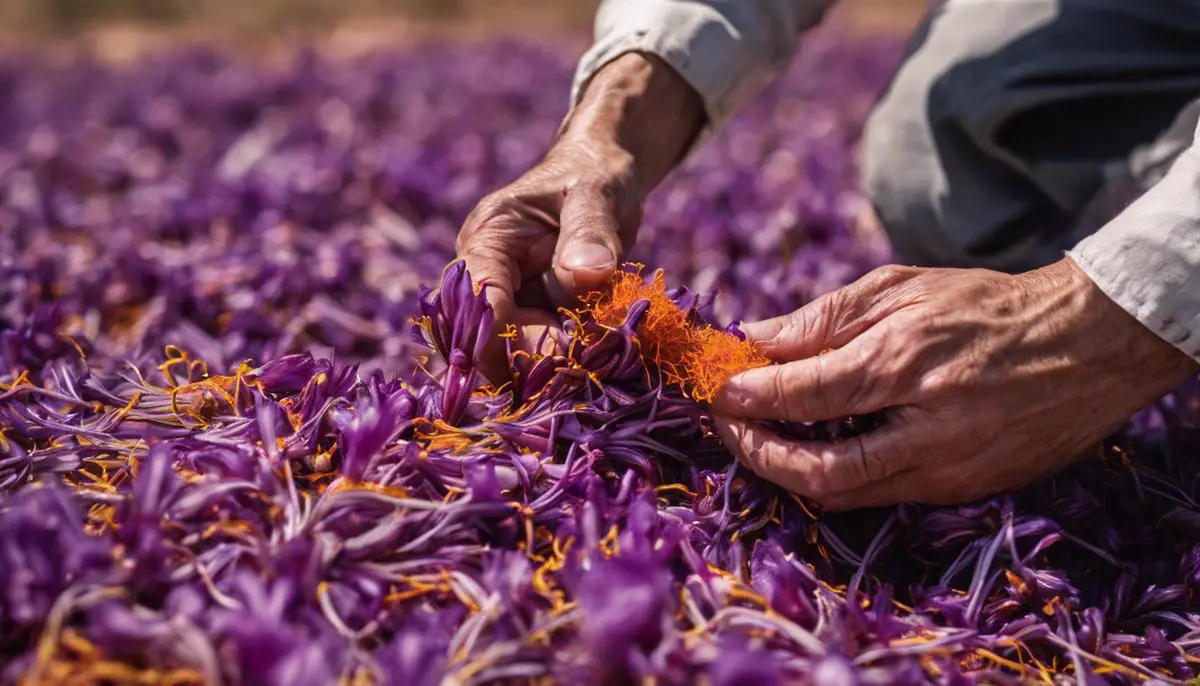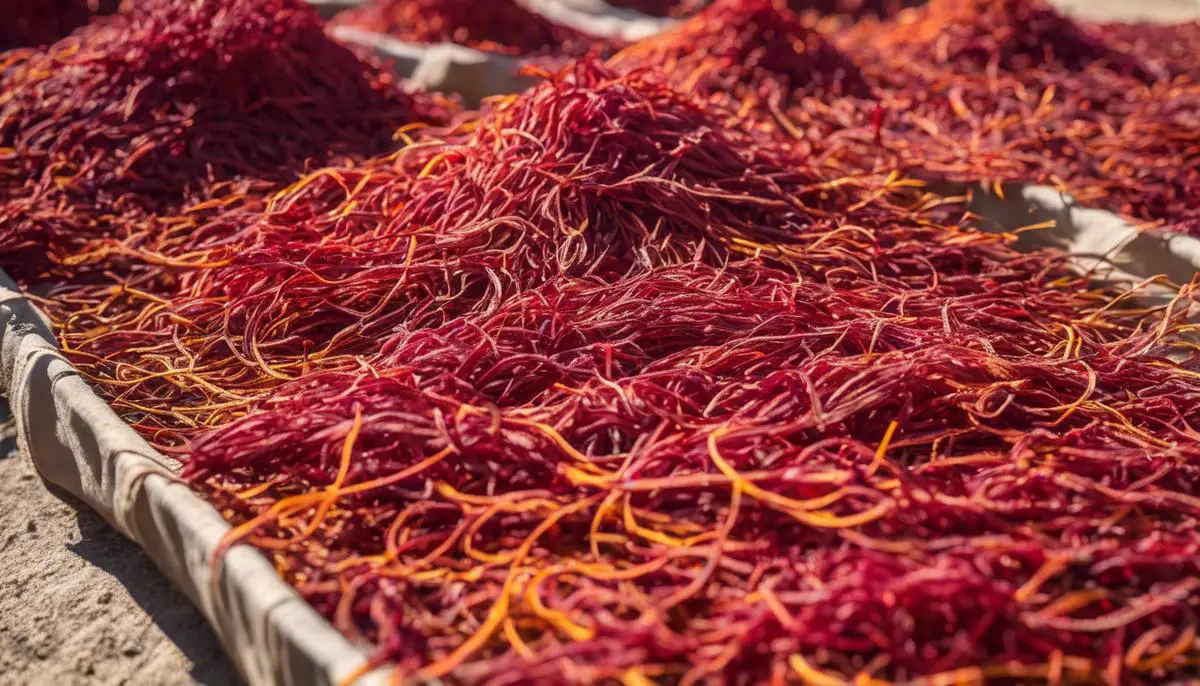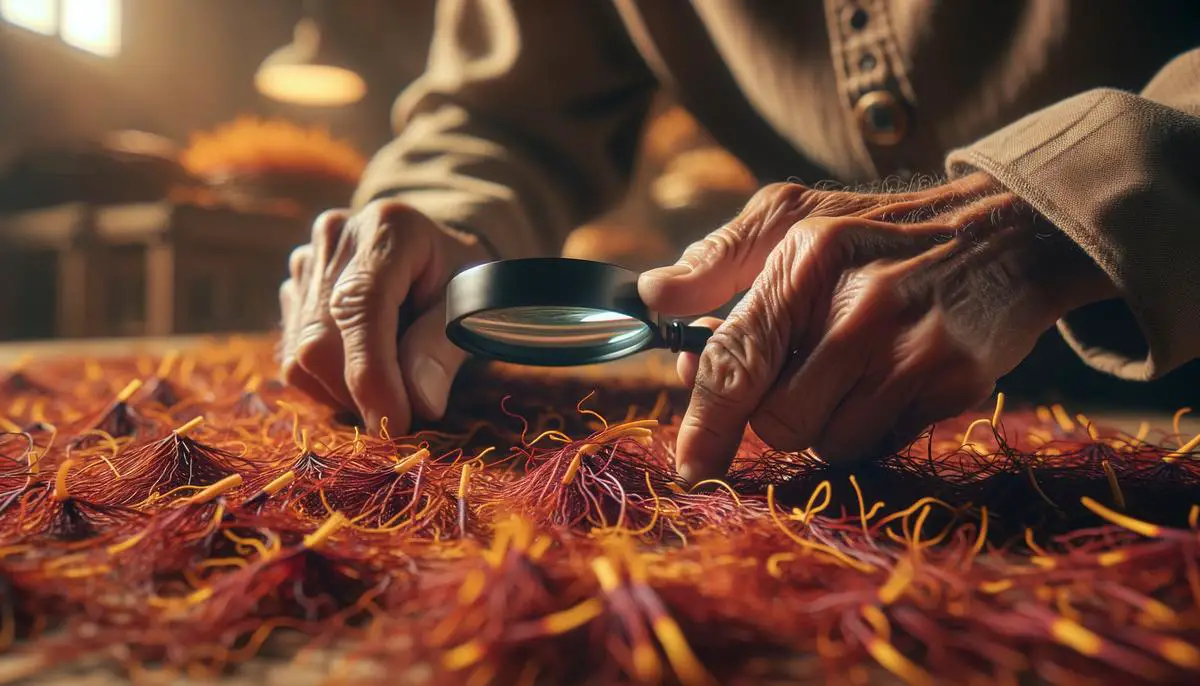
Harvesting Process
Harvesting Spanish saffron involves a delicate dance with nature's clock. The process begins with the Crocus sativus flower, which blooms only once a year for about two weeks in the fall. Each day, farmers rise before the sun to inspect the flowers that have bloomed overnight. Timing is everything; the flowers must be picked as soon as they open, usually right after dawn, to protect the saffron stigmas inside from sunlight and moisture.
Once plucked, the real work starts. The flowers are transported quickly to a processing area where skilled workers carefully open each one to extract the three red stigmas inside. This part is all done by hand – it's a task that machines can't replicate due to the fragility of the stigmas. Imagine, it takes about 75,000 flowers just to produce a single pound of saffron!
After collection, the stigmas, which are the saffron, are dried. This step is crucial; it must be done carefully to preserve the spice's vibrant color, distinctive aroma, and unique flavor. Some farmers still prefer traditional drying methods, laying the stigmas out under the sun, while others use dehydrators for more consistent results. Either way, the goal is to reduce the moisture content without compromising the quality of the saffron.
This intensive manual labor is a big reason why saffron is so pricey. Each stigma must be plucked by hand from the middle of a flower that blooms for only two weeks each year. Then there's the drying process, which requires close attention to ensure the saffron doesn't lose any of its prized qualities. Moreover, these flowers demand specific growing conditions, which includes well-drained soil and plenty of sunlight, making the farming area even more restricted.
Throughout this process, it's clear why Spanish saffron holds such value. The effort and precision needed at every step, from picking to drying, underline the dedication of growers. They're not just farmers but custodians of a centuries-old tradition that brings this golden spice from remote fields to kitchens around the world.

Culinary Uses
When the precious threads of Spanish saffron infuse their hue into dishes, it's like watching a culinary artist at work, painting flavors and colors with a deft touch. The distinctive aroma and taste of saffron elevate the dishes it graces and invites a rich history and tradition to the table. Let's explore the diverse and sumptuous culinary world where Spanish saffron shines as the star ingredient.
Paella, Spain's Signature Dish
No conversation about Spanish saffron's culinary uses would be complete without mentioning paella. This iconic dish, a symphony of seafood, meats, and vegetables mixed with seasoned rice, finds its soul in the golden threads of saffron. The spice imparts a warm, golden color and infuses the entire dish with a rich, earthy flavor and a hint of sweetness — a testament to the complexity Spanish saffron brings. Paella embodies the essence of Spanish culture, where each region boasts its own version, but the constant, the soul of the dish, is always saffron.
Bouillabaisse, A Taste of Provence
Crossing borders into France, saffron plays a pivotal role in bouillabaisse, a Provençal fish stew that brings the bounty of the sea to your plate. This dish combines various fish and shellfish, each contributing its unique texture and flavor, into a tomato-based stew enriched with spices and herbs. Here, saffron's role is to enhance and harmonize, melding the flavors into a coherent whole that whispers of sea breeze and spices.
Risotto, An Italian Masterpiece
In Italy, risotto is a dish where rice slowly cooked in broth becomes a canvas for saffron's artistry. The addition of Spanish saffron to a risotto transforms it with its vibrant yellow color and subtle flavors. It complements the creamy texture of the rice, adding layers of depth with its floral and musky notes. Whether in Milan's famed Risotto alla Milanese or as a base for an array of Italian specialties, saffron is indispensable.
Beyond Traditional Uses
Spanish saffron is versatile and shines in a myriad of culinary applications. From giving a luxurious twist to baked goods with its musky sweetness to elevating simple dishes like mashed potatoes into something extraordinary with its vibrant color and flavor, saffron proves its mettle. In desserts, it introduces an exotic note to panna cottas and citrus-flavored pastries, transforming them into memorable dishes.
Crafting Beverages
Spanish saffron ventures into the world of beverages as well. Saffron-infused teas delight with their golden warmth and tantalizing aroma, offering a sip of relaxation. Cocktails flavored with saffron stand out for their uniqueness, adding a touch of luxury to any gathering.
Spanish saffron's culinary applications are broad and deep. From traditional dishes that speak of its history to modern uses that push culinary boundaries, saffron remains unparalleled. Its distinct flavor and color are not just ingredients but an experience — a golden thread weaving through the fabric of world cuisine, enhancing and enchanting wherever it goes.

Cultural Significance
Embedded deep within the tapestry of history and culture, the golden threads of Spanish saffron are spun from more than just a culinary perspective. This esteemed spice holds a significant place in the heart of Spanish heritage and beyond, marking itself as a cultural artifact that has weathered the passage of time. To understand Spanish saffron's cultural significance is to delve into its vibrant journey through history, where it transitioned from an embodiment of luxury and medicine to an indispensable jewel in the crown of global culinary traditions.
A Legacy Tinted with Gold
Spanish saffron once served as a symbol of wealth and opulence, not merely due to its price but for its versatility in dyeing royal garments with its radiant, sun-like hue. Its rarity and the labor required for its production crafted a mystique around saffron, elevating its status to a revered luxury. It was the gold that bloomed—a treasure of the earth that adorned the fabric of society, both literally and metaphorically.
Saffron's enchantment extended beyond the textile domain into the realm of medicine, where ancient practitioners championed its use. They revered its purported healing properties, ranging from alleviating melancholy to offering antidotes against poison. This reverence for saffron is a testament to its integral role in shaping the foundation of health and wellness beliefs in ancient cultures.
From Fields to Festivals: A Cultural Phenomenon
In the heartlands of Spain, particularly in regions like La Mancha, saffron is more than a spice. It represents the soul of the land—a narrative of resilience, teamwork, and tradition preserved through generations. The harvesting season transforms fields into a celebratory canvas, where communities come together to harvest and process the saffron crocus under the golden autumn sun. This communal spirit breathes life into the Saffron Festival, an annual event that festoons the air with music, dance, and the joyous pride of preserving a heritage. It transcends agriculture, stepping into the realm of communal identity and shared heritage.
Culinary Threads Weaving Cultural Identities
Perhaps nowhere is saffron's cultural significance more pronounced than in the kitchens where it is used. Spanish saffron has transformed regional dishes into legacies, telling stories of the land, climate, and people. Each strand of saffron in a dish is a whisper from the past, invoking tales of conquests, trade, and cross-civilizational exchanges.
Saffron's introduction into Spanish cuisine can be traced back to the Arab rule in Spain, marking a period of cultural and gastronomic fusion that shaped much of what is considered traditional Spanish cuisine today. Dishes like paella, which have gained international fame, are culinary canvases showcasing saffron's vibrant color, unique flavor, and historic journey.1
Moreover, saffron's incorporation into religious ceremonies and traditional medicines underscores its profound integration into cultural mores and personal rituals across different societies. It is a spice that has seasoned not just food but life itself, marking milestones, celebrations, and everyday moments with its presence.
In appreciating Spanish saffron's cultural significance, we unravel a fascinating journey of luxury, tradition, and communal spirit. It's a journey that highlights how a simple spice has become entwined with the very essence of cultural identities and culinary heritage, especially in Spain where each harvest inscribes once more the age-old narrative of "red gold" into the annals of time. Spanish saffron continues to be not only a cherished seasoning but also a vibrant thread in the cultural tapestry of humanity.

Conservation Challenges
In the mosaic of agricultural staples, Spanish saffron blooms with an unmatched allure, yet its cultivation faces an array of contemporary challenges. From the unpredictability of climate change to the strenuous labor demands and the shadow of adulteration, the road to harvesting this "red gold" is fraught with obstacles. Unraveling these issues emphasizes the fragility of such a revered tradition and the efforts required to secure its future.
Climate Change: A Threat
Climate change emerges as a formidable adversary against the delicate art of saffron cultivation. With its specific environmental demands, including precise temperatures and well-timed rainfall, saffron is particularly vulnerable to weather anomalies. Rising temperatures, unexpected rainfall patterns, and extreme weather events jeopardize the delicate balance required for the crocus sativus to thrive. In regions like La Mancha, where the identity and livelihood of communities are intertwined with saffron cultivation, these shifts promise profound impacts. Adapting to climate change has become imperative, leading to innovative practices ranging from the utilization of controlled environments to experimenting with new cultivation regions that meet saffron's climatic demands.
Labor Shortages: A Challenge to Tradition
The labor-intensive nature of saffron cultivation, requiring the meticulous handpicking and processing of the stigmas, positions it as a bastion of traditional agriculture. Yet, it's this very reliance on manual labor that presents a significant challenge. As younger generations migrate towards urban centers and alternative employment opportunities, rural areas face a shrinking pool of potential laborers. This shift threatens a generations-old tradition, sparking concerns over the sustainability of saffron cultivation relying on manual techniques. Bridging this gap demands creative solutions—from enticing younger populations back into agriculture with sustainable and profitable models to incorporating technology that complements traditional methods without sacrificing the essence of craftsmanship that saffron is known for.
The Risk of Adulteration
In a market where authenticity commands a premium, the temptation towards adulteration lurks. Given saffron's high value, instances of adulteration with cheaper substitutes or artificial enhancements pose a significant threat to consumer trust and the integrity of saffron's legacy.2 Protecting against this risk requires stringent quality controls, traceability systems, and a commitment to transparency throughout the cultivation and distribution channels. Efforts such as Protected Designation of Origin (PDO) status for regions like La Mancha represent steps towards preserving saffron's authenticity, ensuring that only saffron grown in these traditional fields can bear the celebrated name.
Preserving Tradition Through Innovation
In the face of these challenges, the cultivation of saffron finds resilience through adaptation and innovation. Technological solutions such as precision agriculture and greenhouse cultivation are explored as means to mitigate climate impacts and optimize growing conditions. Innovation extends beyond technology, embedding itself in practices that embrace sustainability while honoring tradition. From water conservation techniques that reflect respect for the environment to fair labor practices that rejuvenate community participation, the evolution of saffron cultivation is marked by a synergy between age-old wisdom and contemporary needs.
While the challenges facing saffron cultivation today are multifaceted, they are met with a resilient spirit and inventive solutions. Whether addressing climate uncertainties, labor shortages, or the specter of adulteration, the saffron community remains dedicated to preserving this golden thread of culinary and cultural heritage. Embracing both tradition and innovation, saffron cultivation continues to evolve, ensuring that future generations can still savor and celebrate this enchanting spice.

The cultivation of Spanish saffron embodies a profound connection between tradition and innovation, between the land and its people. It's a practice steeped in history yet facing modern challenges with resilience and creativity. The enduring legacy of saffron, with its golden threads weaving through culinary and cultural narratives, highlights not just a spice of high regard but a symbol of communal identity and perseverance. As such, Spanish saffron remains a cherished heritage that continues to inspire and unite across generations.
- Almodóvar A. The Flavors of Al-Andalus. In: Goldstein D, ed. The Oxford Companion to Sugar and Sweets. Oxford University Press; 2015:285-286.
- Sánchez AM, Maggi L, Carmona M, Alonso GL. Saffron authenticity and quality evaluation by 1H-NMR metabolomics. In: Preedy VR, ed. Saffron. Academic Press; 2020:187-211.



